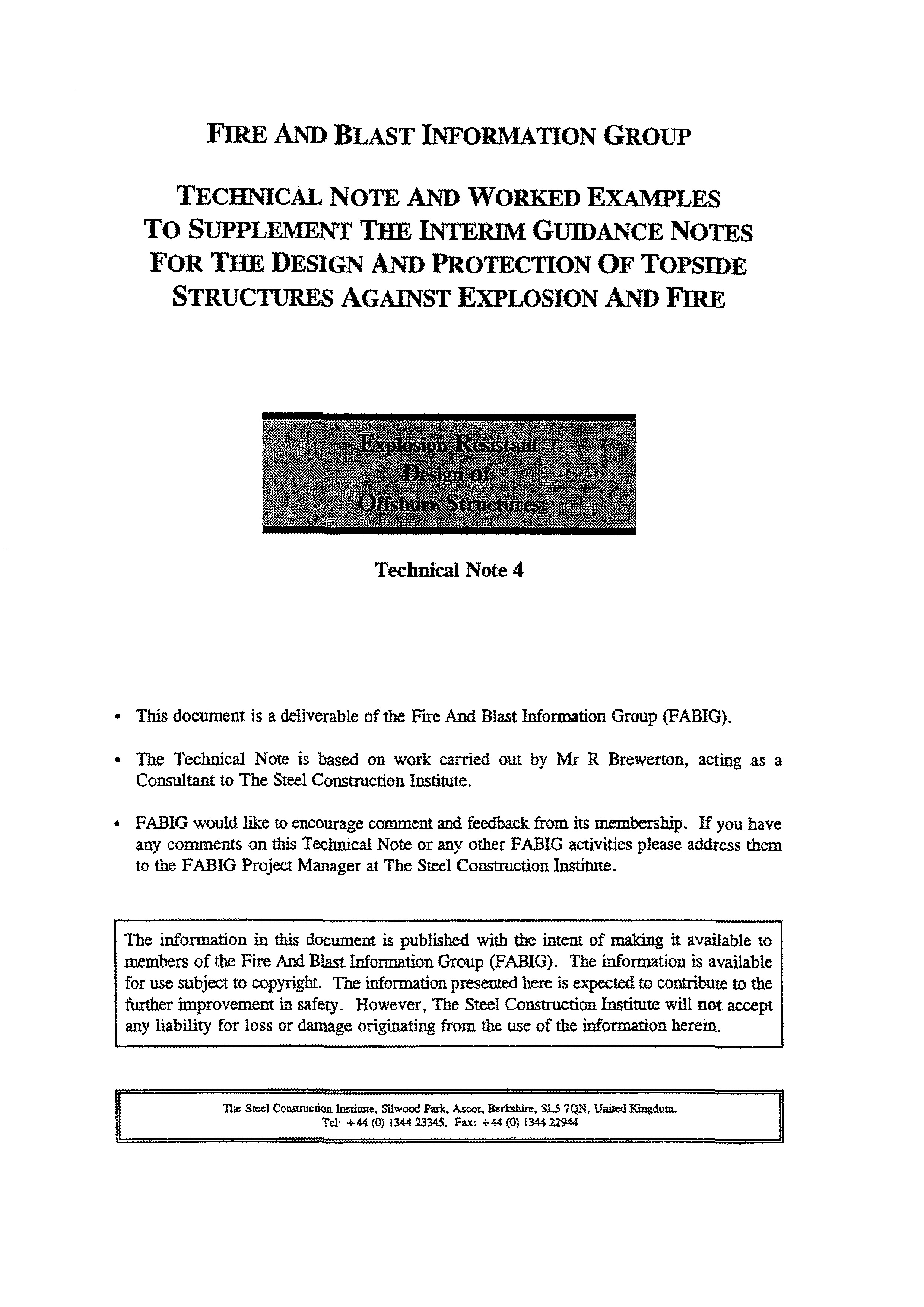Technical Note 04
Explosion Resistant Design of Offshore Structures

FABIG Members: Log-in to access all FABIG resources LOG IN
SUMMARY
Where gas explosions represent a credible risk, platform topsides have to be designed to withstand explosion loading. There are two aspects to consider: firstly loading on the structure and secondly loading and effect on equipment. This technical note deals principally with the first aspect but is also relevant to the second because the performance of the structure, e.g. deflection and acceleration, affects the equipment mounted on it. It is also relevant to the evaluation of the strength and deformation capacity of the equipment items themselves, e.g. pipes and vessels.
This Technical Note covers both design of new platforms and reassessment of existing structures and is designed to supplement Sections 3.5 and 5.4.4 of the Interim Guidance Notes (IGN's).
Several methodologies are presented: from simple hand methods to complex non-linear finite element analysis (NLFEA) for determining ultimate strength. In practice a mixture of methods will be used on a given installation. For new designs the emphasis will be on the simpler methods but for structural reassessment it will often be necessary to quantify strength reserve and for this more complex methods of analysis may be required.
- INTRODUCTION
- GENERAL CONSIDERATIONS
-
The Goal of Inherent Safe Design
- Selecting Design Blast Pressures
- Basic Structural Form
- Primary Response and Rebound Response
- Designing for Blast Wind
- Minimising the Extent of Damage from an Explosion Event
- Inherent Blast Capacity of Structures Not Assessed for Blast
- Topsides Structural Design Specification
- Design Accident Loads Specification
-
- PERFORMANCE STANDARDS
- Low-Level Performance Standards
- Performance Standards for Material Behaviour
- Performance Standards for Behaviour of Structural Elements
- Impact of Performance Standards on Fire Endurance
- INPUT LOADING REQUIREMENTS
- Near-Field Effects (Areas Within the Explosion Domain)
- Far-Field Effects (Areas Outside the Explosion Domain)
- Summary Guidance on Preparation of Basic Design Explosion Loads
- MATERIAL RESPONSE TO DYNAMIC LOADING
- Strain Rate Effect
- Typical Strain Rates in Explosion Response Design
- Strain Rate Effect in Weldments and at Structural Discontinuities
- Statistical Distribution of Characteristic Material Strength and Manufacturing Tolerances
- Summary Procedure for Determining Enhanced Yield Stresses for Design
- STRUCTURAL RESPONSE
- General
- Single Degree of Freedom (SDOF) Method
- Multi-Degree of Freedom Analysis
- DESIGN CODE CHECKS
- General
- Local Buckling for Members Working Beyond the Elastic Limit
- Flexural Buckling of Struts and Lateral Torsional Buckling of Beams Working Beyond the Elastic Limit
- Flange Buckling into Web (Web Crushing) and Flange Curling
- Membrane Tension Forces in Plating and Reactive Compression Forces in Members
- ASSESSING THE ADEQUACY OF THE STRUCTURE AT THE END OF THE EXPLOSION EVENT
-
Input to Fire Response Analysis
-
Input to Equipment Response Analysis
-
- PRACTICAL CONSIDERATIONS
-
Blast Walls
-
Structural Columns, Ties and Braces
-
Module Foundations
-
Joints
-
- REASSESSMENT FOR INCREASED LOADING AND STRUCTURAL MITIGATION
- REFERENCES
APPENDICES
- Dynamic Load Factors: Supplementary Information
- Membrane Stresses in 8 mm Deck Plating
- Calculation Examples
Online purchase options:
Non-Members of FABIG are able to purchase PDF copies of the FABIG Technical Guidance documents.